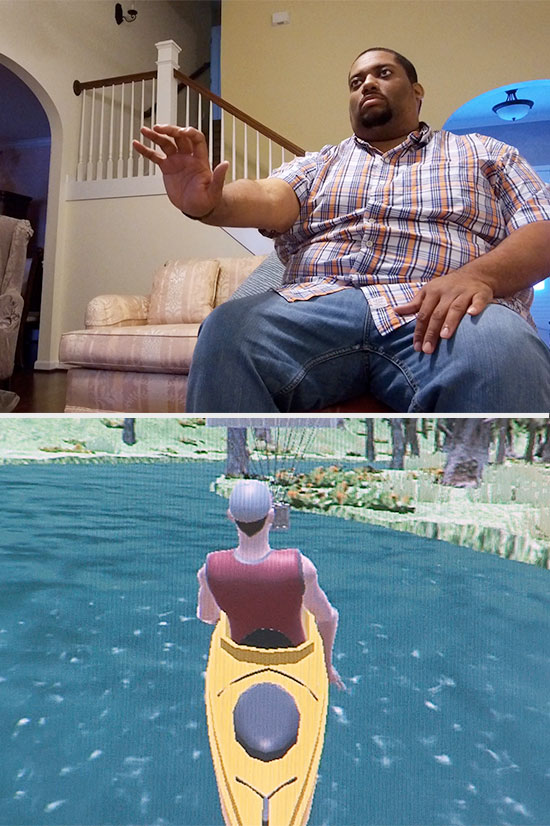Need more information? Contact us
Video by: UAB Visual Content
BIRMINGHAM, Ala. – Constraint-Induced Movement therapy— a behavioral approach to the rehabilitation of movement and speech after brain injury developed at the University of Alabama at Birmingham— is being translated to a video game version called Recovery Rapids through an ongoing clinical trial.
 Jeremy Reynolds, above, participates in the at-home video game therapy to treat his stroke-affected hand. The game, Recovery Rapids, places the user in a kayak traveling down the river to complete activities such as paddling and reaching for fruit with the more affected hand.CI therapy, created by the research group led by Ed Taub, Ph.D., allows patients to learn to improve speech and movement of the parts of their bodies affected by stroke and other types of brain injuries. By encouraging regular use of the the impaired function and limiting other ways to accomplish daily activities, the patient’s brain rewires itself to regain a higher level of function.
Jeremy Reynolds, above, participates in the at-home video game therapy to treat his stroke-affected hand. The game, Recovery Rapids, places the user in a kayak traveling down the river to complete activities such as paddling and reaching for fruit with the more affected hand.CI therapy, created by the research group led by Ed Taub, Ph.D., allows patients to learn to improve speech and movement of the parts of their bodies affected by stroke and other types of brain injuries. By encouraging regular use of the the impaired function and limiting other ways to accomplish daily activities, the patient’s brain rewires itself to regain a higher level of function.
These therapies have proved to significantly improve the quality of movement and the amount of use of the more-affected arm or leg for common daily living activities in most patients who have been treated. Significant improvements have also been observed in patients treated for difficulty with speech.
“We know from several randomized controlled trials that patients with stroke, like the individuals who will participate in this trial, obtain large improvements in the use of their stroke affected arm in everyday life after CI therapy when it is delivered face-to-face in the clinic,” said Gitendra Uswatte, Ph.D., professor in the College of Arts and Sciences’ Department of Psychology and associate director of the CI Therapy Research Group and Taub Therapy Clinic. “Patients who did not use that arm to carry out activities like eating, combing your hair, and picking up a telephone begin to do so after in-clinic CI therapy.”
The video game therapy allows patients to receive treatment from home, while still benefiting from the innovative CI therapy techniques and therapist interaction.
“Given the lower cost and increase in access to treatment made possible by the virtual reality version of CI therapy, the virtual reality version will represent an advance for patients even if the treatment gains are only two-thirds to half as large as for the in-clinic version of CI therapy,” Uswatte said.
Recovery Rapids can be played on a home video game system that is supplied by the study. The treatment and testing that will be done at the University of Alabama at Birmingham is part of a multi-site clinical trial directed by Lynne Gauthier, Ph.D., assistant professor of Physical Medicine and Rehabilitation at The Ohio State University, whose research group designed the game.
The game contains tasks designed to exercise a variety of arm movements and automatically progresses with the play increasing in difficulty as the patient improves. Patients virtually kayak down a river using the game system and perform tasks that will force them to exercise their affected body part, avoiding use of the opposite limb completely. While playing the game, patients encounter tasks such as paddling, reaching for fruit on trees, avoiding rocks and fishing.
The game is also customizable to the patient’s needs. For example, if a patient has more trouble with hand activities, the game can be customized to present more hand tasks.
Patients in the study wear activity trackers on their wrists that monitor the movement of the arms, and provides real-time feedback on how much they are using their affected arms versus non-affected arms outside of the game.
Interaction with a therapist via an Internet-based audiovisual link several times per week helps the patients to translate gains made during gameplay at home into improvements on everyday tasks. By having rehabilitation at their fingertips, stroke patients can drive their own recovery.
Jeremy Reynolds participated in the trial after suffering a stroke and undertaking standard physical rehabilitation at UAB.
“I had a stroke in January of 2015 and I lost a lot of the use of my right arm, well mainly my right hand,” Reynolds said. “I had been through physical and occupational therapy, and was looking for another way to get the use of my hand better than it was.”
He knew he wanted to try the CI therapy video game therapy after learning about it from his mother, who saw a flier with information on the trial.
Reynolds says CI therapy worked for him.
“CI therapy really forces you to use your ‘bad’ hand, so in your daily life you start to use the affected hand more, whether it being opening your car door, carrying a bag or really anything,” Reynolds said. “The video game makes therapy a little easier, and more fun. It’s definitely more convenient as well, and I believe it works.”
Stroke patients who are interested in participating in the trial are encouraged to contact (205) 934-9768.
Eligible patients are those who are more than six months after a stroke, can partially open and close the hand, and have some movement of the wrist, elbow and shoulder. Eligible patients will be randomized to standard CI therapy, home-based gaming CI therapy, or standard physical therapy. Treatment will be at no cost to the patient.